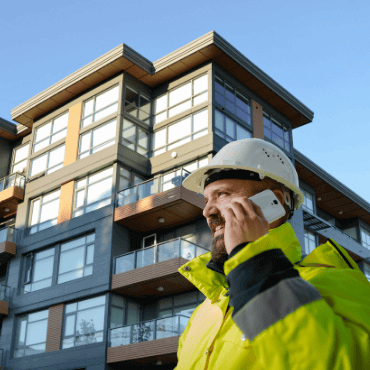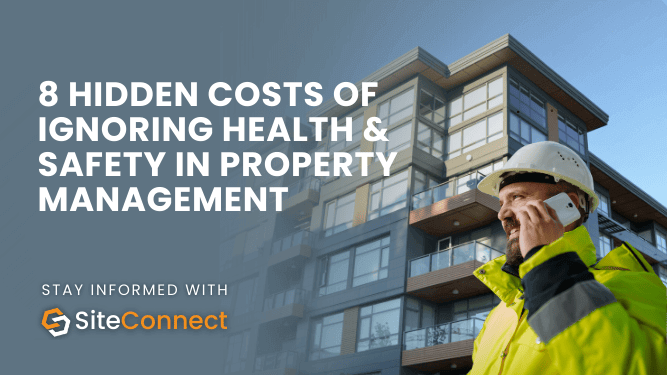Health and safety isn’t just a compliance issue for property managers, it’s a business-critical responsibility that affects every part of your operation. While the obvious risks like legal action or regulatory fines are well-known, there are less visible but equally damaging costs that emerge when health and safety is not prioritised.
Here are 8 hidden costs that property management professionals often overlook and why proactive health and safety management pays off.
1. Rising Insurance Premiums and Reduced Coverage
Property portfolios with poor health and safety records become red flags for insurers. Frequent claims or incomplete reporting can not only push premiums higher but may also result in reduced coverage options. In some cases, insurers may exclude certain high-risk activities altogether, leaving property managers exposed.
A structured safety management system provides real-time evidence of proactive risk control. By showing insurers a digital record of inspections, hazard resolutions, and corrective actions, property managers strengthen their case for lower premiums and more comprehensive coverage.
2. Expensive Legal Liabilities That Extend Beyond Immediate Claims
An accident in one building doesn’t just trigger a single claim. Legal liability often cascades: claims for negligence, costs for long-term injury support, and the ripple effect of compensation for affected tenants. Even when claims are successfully defended, the legal fees and management hours required can be significant.
Digital tools help property managers establish a clear duty-of-care trail. Contractor inductions, hazard registers, and digital permits to work are time-stamped and stored, making it easier to demonstrate compliance and reduce exposure in court.
3. Regulatory Penalties and the Cost of Repeated Audits
Failing an audit doesn’t just mean a one-off fine. Regulators may impose follow-up inspections, mandatory reporting requirements, or increased monitoring, all of which drain time and resources. Repeat audit failures can also damage professional standing with owners and investors, who expect smooth compliance as part of your service.
Automated reminders and checklists built into systems like SiteConnect prevent missed inspections and create transparent records that stand up under regulatory scrutiny.
4. Operational Downtime and Tenant Disruption
Unsafe conditions often lead to temporary closures (anything from shutting down a lift due to missed inspections to sealing off a building after a contractor injury). These disruptions don’t just inconvenience tenants, they create reputational friction that makes it harder to renew leases or attract new tenants.
Proactive safety management ensures issues are caught early, with digital hazard reporting making it easy for staff and contractors to flag risks before they result in downtime.
5. Reputational Erosion in a Competitive Market
Reputation is currency in property management. A single high-profile incident, whether through media coverage or tenant complaints on social platforms, can undermine years of trust. Even if the incident seems small, the perception that a property is “unsafe” is difficult to shake, leading to reduced asset value and tougher leasing negotiations.
By embedding safety into daily operations and using real-time dashboards to demonstrate accountability, property managers can reinforce confidence with both owners and tenants.
6. Strain on Contractor Relationships and Supply Chain Reliability
This hidden cost is often overlooked. Contractors are the backbone of property management, but if they feel a site is unsafe, disorganised, or lacking in compliance processes, they may deprioritise your jobs or charge a premium to take on the additional risk. In extreme cases, top-tier contractors may refuse to work on your sites altogether, leaving you reliant on less experienced or more expensive providers.
Digital contractor management systems streamline inductions, insurance tracking, and compliance checks. This not only protects you legally but also builds stronger, trust-based relationships with your contractor network.
7. Higher Vacancy Rates
This is one of the most harmful hidden costs. Poor health and safety management can make tenants feel unsafe or unsupported, leading to higher turnover. Prospective tenants who hear of past incidents may be reluctant to sign leases, while investors may discount asset value if a property is associated with safety risks.
8. Reduced Asset Value
Over time, ignoring safety directly erodes asset value and reduces the long-term profitability of the property. A visible, digital-first safety program reassures tenants, owners, and investors that the property is being managed responsibly, supporting stronger valuations.
Why Proactive Health & Safety is the Smarter Investment for Property Managers
The costs of ignoring health and safety in property management extend far beyond fines and lawsuits. From insurance and legal exposure to strained contractor networks and reduced asset value, the financial and operational impacts ripple across the entire property portfolio.
By adopting digital property management safety, property managers gain real-time visibility, centralised record-keeping, and automated compliance tools that protect people, properties, and profits.
Property management safety isn’t just about meeting legal obligations, it’s about protecting the long-term success of your portfolio. The hidden costs of ignoring it are too high to overlook.


